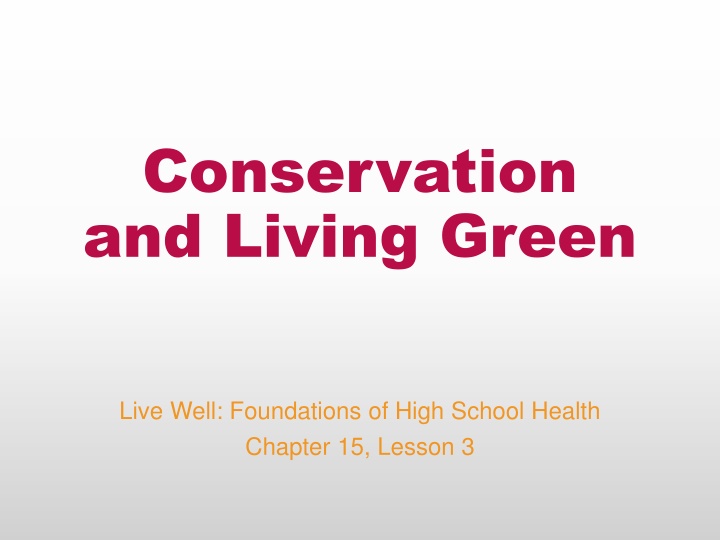
Living Green and Protecting the Environment: Key Practices and Principles
Learn about living green, environmental impact awareness, conservation methods, and practical steps to protect the environment. Understand the importance of reducing, reusing, recycling, treating, and disposing responsibly to preserve natural resources and biodiversity.
Download Presentation

Please find below an Image/Link to download the presentation.
The content on the website is provided AS IS for your information and personal use only. It may not be sold, licensed, or shared on other websites without obtaining consent from the author. If you encounter any issues during the download, it is possible that the publisher has removed the file from their server.
You are allowed to download the files provided on this website for personal or commercial use, subject to the condition that they are used lawfully. All files are the property of their respective owners.
The content on the website is provided AS IS for your information and personal use only. It may not be sold, licensed, or shared on other websites without obtaining consent from the author.
E N D
Presentation Transcript
Conservation and Living Green Live Well: Foundations of High School Health Chapter 15, Lesson 3
Write About It What does it mean to live green? Do you think about the environmental impact of your daily life? Why or why not?
Can you . . . Explain the five ways to protect the environment? Provide two examples of commonly recycled products and what they are used for? Explain what it means to live green and identify four related actions?
Conserving Natural Resources Conservation refers to the steps people take to prevent the exploitation, destruction, or neglect of natural resources. By conserving natural resources, we can help to preserve biodiversity. Biodiversity refers to maintaining the balance of all living things (plants and animals) in an area.
Protecting the Environment According to the EPA, there are five ways to protect the environment: Reduce Reuse Recycle Treat Dispose
Reduce The most impactful way to protect the environment is to reduce the amount of trash and pollution we create in the first place. Focus on energy sources that create less pollution. Use renewable energy sources, a type of energy that will never run out (e.g., energy generated from the sun and wind).
Reuse On average, each person in the United States produces five pounds of waste every day. Strategies for reuse include the following: Try buying fewer items and reuse what you have. Reuse plastic shopping bags. Give clothing items you no longer want to someone who will use them longer.
Recycle (1 of 2) Recycling is the process of collecting and processing materials that would otherwise be thrown away as trash and turning them into new products. Recycling reduces the amount of trash that goes into landfills. In most places, plastics, paper products, and glass are commonly recycled. (continued)
Treat Treating substances that may be dangerous to the environment can protect people and the environment from the damage the substances cause. Examples include treating contaminated water for safe use and contaminated land for future use.
Dispose Dispose properly of materials that can t be recycled or otherwise treated. This includes not littering; properly disposing of items containing toxic or dangerous substances so that they don t contaminate the water, soil, or air; and disposing of batteries at designated areas.
What Does Living Green Mean? Living green means being aware of the effect your lifestyle and choices have on the environment. A way to give back to the natural environment is to plant a tree. Another way is to compost your food waste. Composting involves placing food scraps and waste into outdoor bins for decomposition. The resulting compost can be mixed into the soil of a garden or yard.
Tips for Being a Green Student Take notes electronically. Carry a water bottle. Use a reusable lunch bag. Power down. Recycle your paper. Walk, bike, carpool, or use public transportation. Take only what you ll eat.
Being Green at Home Reuse bags. Buy less. Borrow more. Use energy-efficient light bulbs. Save energy and sleep better. Eat sustainable seafood. Eat less meat. Watch your water usage. Buy eco-friendly products.
Skill-Building Challenge This lesson provides you with examples of ways you can live green. Select three to five ideas presented in the lesson and try to do them consistently over a week or longer. Select ideas that you value and that are realistic. Write down your choices and create a log to track your progress.
